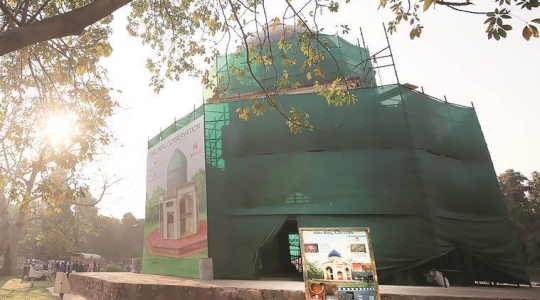Subz Burj: Oldest double-domed monument in the heart of city set to be renovated
(Source: Amit Mehra)The 22-metre high Sabz Burj, at the intersection of Mathura Road and Lodhi Road, has led a lonely life. The Sabz Burj has suffered abuse due to its location — there is pollution, traffic and accompanying vibrations,” said Nanda. Surrounded by the cacophony of screeching honks from cars, the sprawling lawns of the 16th Century tomb play host to mostly pigeons. “This project is significant because the monument is in the middle of the city, at a busy intersection… people will see the restoration work, it won’t be hidden,” said Nanda. The 16th century tomb is being renovated by the Aga Khan Trust for Culture and Archaeological Survey of India.
The 16th century tomb is being renovated by the Aga Khan Trust for Culture and Archaeological Survey of India. (Source: Amit Mehra) The 16th century tomb is being renovated by the Aga Khan Trust for Culture and Archaeological Survey of India. (Source: Amit Mehra)
The 22-metre high Sabz Burj, at the intersection of Mathura Road and Lodhi Road, has led a lonely life. Surrounded by the cacophony of screeching honks from cars, the sprawling lawns of the 16th Century tomb play host to mostly pigeons.
By the end of 2018, this sombre atmosphere is expected to change, as Aga Khan Trust for Culture (AKTC) and Archaeological Survey of India (ASI) have begun conservation work at the double-domed Sabz Burj.
Since November, artisans have been putting in place glazed tiles in two shades of blue, green and yellow on the drum of the tomb, which fell off years ago. “We chose not to go with modern tiles… these have been made by locals using old techniques, and have been hand-compressed. The tiles are not just decorative, they also protect the tomb from water,” said Ratish Nanda, CEO, AKTC.
With “sabz” in its name, which means “green”, the dome of the tomb is covered in blue tiles — considered to be a restoration error done in the 20th century. These tiles will be left intact during the year-long restoration work. “The foundation has to be stabilised, the missing sandstone lattice screens have to be restored and the cracks on the dome have to be fixed, among other work. The Sabz Burj has suffered abuse due to its location — there is pollution, traffic and accompanying vibrations,” said Nanda.
The restoration work done in the 20th century, using cement and chemicals, will be removed with the help of international expertise. It is believed that a nobleman from the Mughal era was buried here, and the tomb was built between AD 1530-40.
“The nobleman must have been someone important as the tomb is in such close proximity to the Nizamuddin Dargah… In the early 1900s, the Nizamuddin police station was being operated out of here,” said an ASI official, present at Sabz Burj on Thursday afternoon.
In the middle of the city, the Sabz Burj faces Humayun’s Tomb, and is a well-known landmark — but most importantly, it’s an architectural treasure as it is one of the earliest examples of Mughal architecture in Timurid-style. It’s also one of the first instances of double-domed tombs in the country.
Even the colourful tiles are a distinctive characteristic of early Mughal style architecture in India. In her book Mughal Architecture (1991), art and architectural historian Ebba Koch wrote, “The use of the typical mosaic tile was confined to a handful of monuments under the Mughals… the use of coloured glazed tiles — so popular in Iran — remained confined to the outer facing of the domes (for example Nili Gumbad and Sabz Burj)”.
Apart from restoration work, the tomb is expected to be illuminated by Havells India Limited, which has joined hands with AKTC and ASI.
“This project is significant because the monument is in the middle of the city, at a busy intersection… people will see the restoration work, it won’t be hidden,” said Nanda.
- 3656 reads
 Ismaili.NET - Heritage F.I.E.L.D.
Ismaili.NET - Heritage F.I.E.L.D.